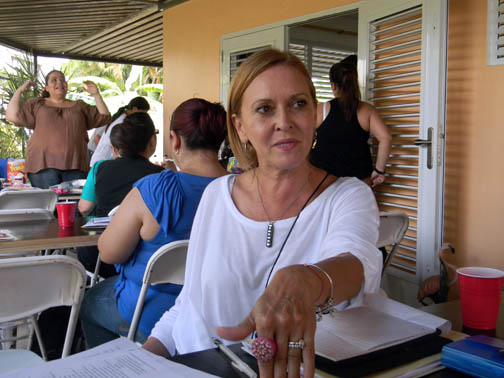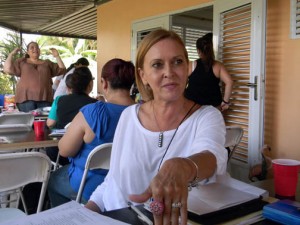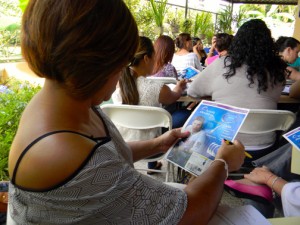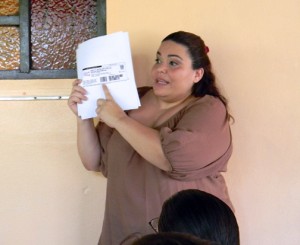Bargain hunters get hands-on lesson in ‘couponing’


Wanda Malavé explains how she goes about shopping for her monthly household supplies on a $100 budget.
She has been a savvy shopper for many years, but about five years ago, mother of three Wanda Malavé took on the task of learning how to master the use of manufacturers coupons in Puerto Rico.
Today, she has a stockpile of hundreds of products at home that she uses for her family, as well as donates to those in need, purchased for a fraction of their retail price — or free.
Malavé, along with about 40 other women, participated in a couponing workshop that took place over the weekend in Bayamón to continue honing her skills and teaching others that it is possible to save hundreds of dollars every month with the help of manufacturers discounts.
“I started out slowly. At first, I would rely on price matching that certain stores offered to get the lowest prices possible,” said the Bayamón resident who holds down a part-time job, while managing a household. “About two years ago, I discovered online sites where I could print coupons from, and that’s when I really got into this practice of couponing.”
She said by clicking into social media websites like “Cuponeando en Puerto Rico,” she was able to learn from others how to organize her coupons and purchases to get stuff either nearly free or completely free.
“I started seeing what they were doing and if it was convenient for me, I would go and make the same transaction,” she said.
Her inclination toward couponing and finding the lowest prices available became even more significant last year, when she had to face personal and family complications.
“My sister had a situation, we have our particular situation with our son, who is bedridden and my husband and I have to make ends meet with my part-time salary and his paycheck,” she said. “I had to find every possible way to save on monthly expenses, so that I could use that money for other things. One way to do that is by couponing and helping others to learn to do so as well.”
Malavé said the expenses related to her ill son alone are between $1,200 and $1,400 a month, on top of her household expenses. However, with her ability to combine manufacturers coupons with store sales, she manages to buy all of her monthly staples on a $100 budget.
“I’ve literally saved hundreds of thousands of dollars because I was spending an average of $400 to $500 a month on what we needed at home,” she said. “Now, it’s $100. We’ve been able to pay off credit cards, live comfortably and have everything we need.”
Malavé’s stockpile room — which she said her grandchildren call “K-mart” — stores everything from paper goods, to make-up, to non-perishable food and beverages. Usually, it’s enough to last her three months.
“I buy produce and meats at the supermarket on the budget I have,” she said. “This couponing thing, if you do it as a science, will help you save a lot and help you have the things you and your family need.”
While there are no specific numbers for Puerto Rico, statistics show that consumers who used manufacturers coupons last year garnered $4.6 billion in savings across the United States through an estimated 305 billion coupons published. Furthermore, shoppers received $500 million more in coupon savings last year, versus 2010 representing a 12.2 percent jump.
Couponing novice
Malavé’s couponing expertise sharply contrasts Marisol Reyes’, also a mother of three from Aguas Buenas, who began taking her first steps in the world of couponing about a month ago.

Marisol Reyes pores over the most recent edition of the P&G Brandsaver catalog, which contains $90-worth of manufacturers coupons.
“I live on a fixed income, so I’ve reached a point in my life when I have to live with the money that I receive. In the past, I used to have certain luxuries that I can’t afford anymore, but I figured that by couponing, I can get to where I can be more comfortable, financially speaking,” said Reyes.
Her “awakening” to the practice of printing and clipping coupons came after standing in line behind another shopper at a drugstore and witnessing how she applied coupons to her purchases to significantly reduce prices at the register.
“I asked her how she had done it, and she lead me to ‘CuponeandoPR.’ That’s when I started seeing all of the information, the vocabulary and began learning where to find my coupons and how to use them,” she said.
“I’ve started taking my coupons to different stores, to see where I can do the best with my budget,” she said. “Participating in the workshop was fantastic because I was able to learn about how to organize myself, study the store flyer and match the sales with available coupons.”
“Obviously, this is about maximizing the money you have and in my case, organizing myself so that I can make my own stockpile. I aspire to have one, because I need to provide for my family, as well as my mother, whom I also help out as much as possible,” she said.
The adoption of manufacturers coupons in Puerto Rico has been gaining ground slowly but steadily in recent years, as companies such as Procter & Gamble, Kraft, Unilever and others have increased the frequency with which they publish and distribute them locally. Retailers are also doing their part by establishing acceptance policies for coupons, taking both the pre-printed and downloadable kinds.
While in a number of states retailers double the face value of manufacturers coupons, in Puerto Rico only K-mart has been doing so regularly, offering to double up to a certain number of them per transaction. The customer must make a $25 pre-tax purchase to be eligible to double either five or 10 coupons of up to $1, depending on what K-mart has advertised that week.
‘This is not about over-buying’
Edith Tapia, who manages the CuponeandoPR site, has been offering training workshops for the better part of the last year, taking her knowledge of couponing and store policies on the road.

Edith Tapia explains the ins-and-outs of “couponing” to a group of women who participated in one of her popular workshops.
“I’ve offered training workshops like the one that took place Saturday to more than 200 people in the towns of Dorado, Cabo Rojo, Ponce, Isabela, Aguadilla and Bayamón. That’s on top of helping at least 25 people a day through email consultations on transactions, store policies, or situations they’ve had at a store and come looking for advice on what to do,” said Tapia, who also has quite a significant private stockpile.
In her workshops, Tapia discusses the legalities of couponing — what is allowed and what is considered fraudulent — where to go to find coupons online, how to organize a shopping trip and even how to treat cash register and management staff, who in some cases “are learning too,” she said.
“You have to be nice and you have to follow the rules. You have to try to establish relationships with them as much as possible, because they can become your ally in your shopping experience,” she said. “Besides, for a retailer, a coupon is more valuable than money because they get paid to accept them.”
Ultimately, teaching how to use coupons to get stuff for cheap or free is not about getting people to over-buy, she said.
“It’s about teaching them to calculate what they need to get them through a three-month period, which is the same frequency with which items go on sale,” she said. “Having a three-month supply is enough for a typical family.”
Tapia has already lined up five more workshops before year’s end, in Quebradillas, Caguas and Guaynabo, which will follow pretty much the same agenda that also focuses on teaching people how to figure out exactly what they should be buying according to their family’s habits and their specific budget.
“The foundation of couponing is having that stockpile because by buying on sale and with coupons, the person will be able to spend that money saved on other things, like paying down debt or even going on vacation,” she said. “Couponing is not about social status, it’s about being smart about your finances.”




